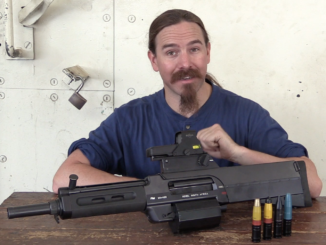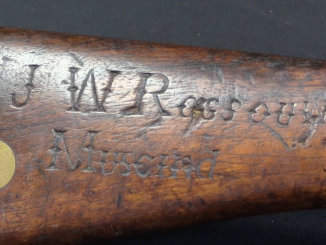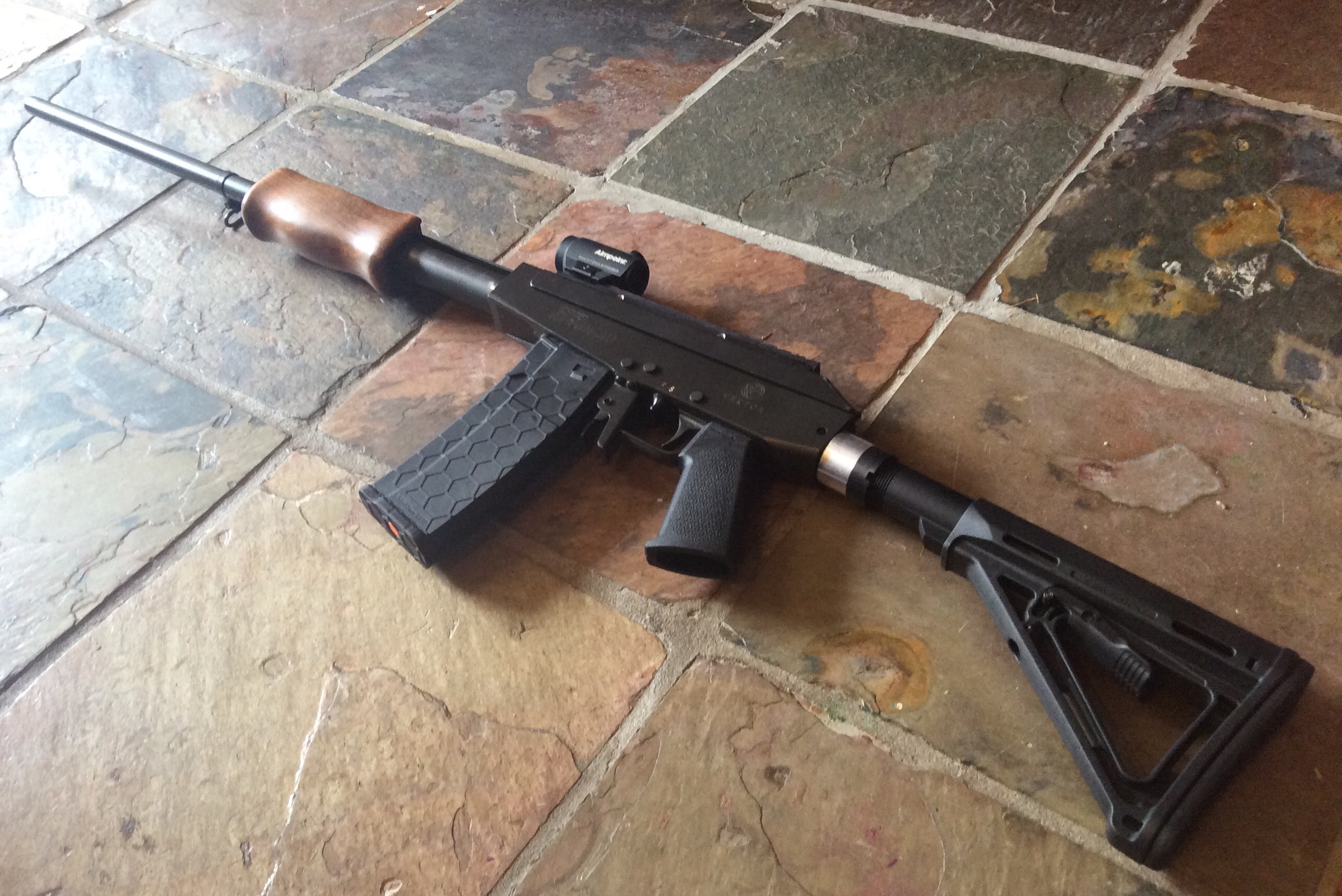Tony Neophytou is the South African designer of several very interesting and innovative firearms: the Neostead 2000 pump shotgun, the NTW-20 anti-material rifle, the NeoPup/Inkunzi PAW, and most recently the NeoStrike/Inkunzi Strike machine gun. He was generous enough to spare some time to sit down with me and discuss his experiences from a career of firearms design, and some advice for anyone who might be thinking of doing the same (“sit down until the urge passes!”). Mr. Neophytou is a remarkably talented designer (or as he would have been called 150 years ago, a “mechanic”) and very humble and self-aware. He is one of a very small cadre of people who have actually undertaken the whole experience of arms design from idea through production, and he doesn’t sugar-coat the perseverance it requires. So if you want to know what it takes to actually do that, then grab a coffee and join us for the next half hour!
Related Articles

Artillery
Inkunzi PAW aka Neopup – 20mm Direct-Fire Grenade Launcher
The Inkunzi PAW (Personal Assault Weapon) is a 20mm shoulder fired semiautomatic grenade launcher designed by Tony Neophytou (and previously known as the Neopup). It is a creative and very interesting weapon system, both […]

Bolt Action Rifles
Boer Lee-Speed Rifle from the Jameson Raid
Lot 1687 in the September 2019 RIA auction. The Jameson Raid in December 1895 was one of the key events in the lead to the second Boer War. Leander Jameson took a force of about […]

Conversion
Vektor H5 Pump Action Galil
This Vektor H5 is one of a handful or semiauto rifles converted to pump action for sale in countries where self-loading rifles are or were restricted (another example is the PAR-3 Romanian pump action AKs […]
34 Comments
2 Trackbacks / Pingbacks
- Video: Interview with a South African Inventor of innovative firearms
- Video: Interview with a South African Inventor of innovative firearms - AfricanCrisis

The only better interview that I could imagine would be with John Moses Browning. This was great!
Totally agree, what marvelous insights into the world of gun design that so many users of weapons take for granted. Well done.
“only better interview that I could imagine would be with John Moses Browning.”
With all due respect to designer of NTW-20, I think that few other could be found, which would also give interesting interview. My first though it that regard was von Mannlicher.
Mannlicher was an ace; he died too young unfortunately. If you consider that he started with firearms quite late (originally worked for railways), he produced impressive line of designs in that short span of time.
“NeoPup/Inkunzi PAW”
So it looks that it might prove to be so-called disruptive innovation
https://en.wikipedia.org/wiki/Disruptive_innovation#Examples
(intentionally linked to section rather than general, as it should made understanding that easier for someone who do not encounter earlier such concept)
He reminds me a lot of Mac from HMG talking about the STG-N they are doing. And HMG is in the process of getting there mags in production and having fun for values of fun with the process.
“some advice for anyone who might be thinking of doing the same (“sit down until the urge passes!””
What can I add is always remember about aim that is what you actually want achieve.
Take for example DARNE aviation machine gun described here:
https://www.ibiblio.org/hyperwar/USN/ref/MG/I/MG-4.html#14
for someone interested in machining sophisticated shapes in metal it would be probably lackluster, for someone assessing external finish too, but it was not desire of its designer. It was optimized for big volume of production or in other need so making 1 examples required possibly small amount of labor, in consequence giving cheaper product.
Citing from link
All Darne machine guns were rough in appearance, being produced in this manner intentionally since refinement in appearance would only add to the cost. Cheapness and ease of manufacture were the main points considered in their design.
is: “(…)in other need so(…)”
should be: “(…)in other words so(…)”
Really fascinating insight and a nice flowing conversation as well!
I would have question for T.N.: do you work for Denel, or are you on your own? The next one would be: where Denel is going? How is SA arms industry in general? Similar like its white farmers?
There is a space left. It could be around better balance of 7.62x51mm guns; less recoil and lower weight. I can be done. They are in demand now, more than ever.
With respect, I think the GPMG role is filled nicely with things like the PKM and derivatives; what is missing is a modern version of the Lafette mounting system that gives the MG its true power.
People keep focusing on the guns; that is actually the lesser of the three legs that the MG team relies on. The gun itself is utterly useless without a well-trained crew that knows what it is doing, and the necessary support (literally) equipment to get that gun properly laid on the enemy targets.
You give me a choice between a mediocre MG with a really good crew and a workable set of accessories, and I’ll chose that every time over a perfect gun with a pack of idiots and a lousy tripod. The guns are only about twenty-five percent of the story; the crew probably forty percent, and the supporting tools with the gun and crew make up the other thirty-five percent.
Hell, just give me a good tripod, a decent set of rangefinding binoculars with a good reticle, some time to train the crews, and I’ll be happy with even a mechanical monstrosity like the M60…
“Lafette mounting system”
Could you be more precise? Deutsch Lafette means just gun carriage and can be used to describe wide range of solutions: https://de.wikipedia.org/wiki/Lafette
Kirk has written extensively about the MG42 and its associated Lafette tripod over on weaponsman.com. Very interesting stuff, which I highly recommend reading. Here’s one place: http://weaponsman.com/?p=22079#comment-181826
“PKM and derivatives”
So what 6Т5 Stepanov mount: http://russianguns.ru/?cat=250
is lacking?
See my post below. I don’t know why it failed to post here…
I meant more personal weapons then crew served. You have valid points though.
” less recoil and lower weight.”
Is Madsen Saetter tripod what are you looking for?
According to http://www.smallarmsreview.com/display.article.cfm?idarticles=3600
Madsen Saetter tripod was an engineering marvel; light weight, easy to fold. It provided a very secure firing platform, furthermore accuracy was enhanced because the mount was buffered. This meant that the machine gun while firing recoiled very gently in a state of equilibrium due to the buffered system. Madsen did well with their gun mounts, so well that they stopped manufacturing weapons altogether and concentrated their efforts on making gun mounts for all the world’s weapons including their old competitors…
I am looking at better control of weapon dynamics. I believe I have solution to that. Yet, no one want to hear it (mental block I guess).
The issue is: world sees two models of rifle – AK and AR and in fact neither one is optimized. That is reason I feel there is space in rifle development. If dynamics are sorted out, weapon can be lighter. Next subject is lower maintenance(or even none at all). AK system is close, AR is just the opposite.
And please, no more about counterweight flying forward with each shot. That does not address reaction to primary input, which comes from locked bolt.
What I mean optimised in this connection is outside of its layout/ construction. AK has achieved maximum with what it is and cannot go further. There is new direction such as BT rifle/ carbine which uses extruded top and moulded grip/ magazine well. This seem to be taking off lately.
Then, there is the issue of internal dynamics. What T.N. presented in PAW is good for large caliber, perhaps in some form in can be applied in small one as well.
Now I am confused, please chose exactly one statement
AK is not optimized
AK has achieved maximum with what it is and cannot go further
As they mutually exclusive, if something can not be further improved this mean it is actually as optimized as it could be.
“issue of internal dynamics”
Under internal dynamics should be that how parts are moving be understood?
“PAW is good for large caliber, perhaps in some form in can be applied in small one as well.”
As experience show, scaling of existing machine gun is possible (that is how many ~12…13 mm machine gun were created), but most often more complicated that it would looks.
” better balance of 7.62x51mm guns; less recoil and lower weight.”
If you could accept ·303 British instead, then maybe solution is Beardmore-Farquhar
https://www.ibiblio.org/hyperwar/USN/ref/MG/I/MG-4.html#15
which was weighing only 16 1/4 pounds with a 77-shot drum magazine attached and loaded that is 7,37 kg, according to query in airwar mass of machine gun itself was 7,04 kg. I am not sure if it counts as less recoil but it is designed so it work without the jarring effect of a straight gas-piston-driven mechanism, so if not even less it apparently is smoother.
Though it must be noted that it is magazine-fed (pan magazine) weapons and I do not know if it could be reworked for belt-fed, but even if so it would probably become heavier in process, nonetheless I presume saving on weight from change magazine->belt would outweight added mass. Limited Rate-of-Fire (for aviation rifle-caliber machine gun) would be advantage, as it would probably fit ground purpose quite well without altering (airwar query states it fired 450…640 rpm).
I said it once before, but it bears repeating…
The 20mm PAW is flat out one of the most useful innovations in firearms to be designed in this century, so far anyways.
So many potential uses. I agree with Ian, as to having design be put into large scale production becoming a game changer for small arms worldwide. Tony is clearly a genius, and his description of the many iterations of Mauser was spot on. It takes real effort to design simplicity.
Few men of greatness are fully recognized in their lifetime, let’s hope that isn’t the case for Tony. He exudes practical wisdom in both depth and breadth, of the full spectrum of the inception-design-production process. I kind of wonder if this video just made history, as though people 100 years from now will watch it and marvel.
Because, just what if, in 100 years, hand held high explosive flat trajectory rifles are as common as AR platforms are now?
Maybe the better question is, why would any forward thinking military NOT prefer to give as much organic firepower to the individual infantryman as possible, rather than just keep apace of the status quo? The arc of history surely seems to favor this thought process.
And like so many things discussed in the video, the light machine gun did not find a home in employment and tactics doctrine for a very long time after its debut. By the way, that same doctrine is now considered world standard. Could the PAW be the forerunner of an altogether new style of weapon employment? When you stop and really consider its potential, the answer, IMHO, becomes obvious. Even if this particular gun commercially is not, the concept by itself is a winner.
Well done, Tony.
_______
And thank you both, Ian and Tony, for posting such fine content, and frank discussion on the true obstacles as well as victories in the world of weapons design. You both do the world a great sevice by making this information available to those seriously considering this path.
T.N’s work is clearly a departure, especially in field of specialized gadgetry (U.S., Korean and Chinese) presented recently. However, as much as he managed to pare it down to basics, I cannot see this to be a general issue. If its objective is destruction of high value targets with acceptable penalty of weight and recoil, he achieved the objective.
But just like with anything, there is more than one capable mind looking for solution of given task. Its a matter of publicity. T.N. received that and he’s got my best wishes.
French PAPOP (Poly Arme POly Projectiles) 35mm prototype/experiments?
Obviously it runs afoul of XM-25 and South Korean RoKA protytpe issues, complexity, etc. But I thought at least one outcome as a simpler projectile? Perhaps I’m wrong.
Thing is, there was a crazy 30mm grenade launcher thought to have been made in Cuba (really the USSR? Perhaps Daweo knows?) that turned up in El Salvador during the late (as opposed to ongoing) upleasantness alongside U.S.-type M79 and M203 40mm launchers in the guerrilla/rebels’ hands during the 1980s?
Yes, I have seen pictures of this Cuban gun. It is in 14.5 x 144 mm caliber. It was used in Angola.
When comes to armaments, Cuba has ongoing working relationship with Byelorussia.
“It is in 14.5 x 144 mm caliber”
Shouldn’t be 14,5 x 114 or is that some new invention?
“30mm grenade launcher thought to have been made in Cuba (really the USSR? Perhaps Daweo knows?) that turned up in El Salvador”
Could you provide any photo or description of how it looks?
30 x 29 mm cartridge (notice that its case length is smaller than bullet diameter!)
https://ru.wikipedia.org/wiki/30_%C3%97_29_%D0%BC%D0%BC
was adopted together with AGS-17, designation for original (first adopted) round is VOG-17.
Most probable candidate from USSR made weapons to appear in 1980s in that region of world is AGS-17.
Query in Russian wikipedia lists among users Cuba and give following link:
http://gruposfuerzasyoperacionesespeciales.blogspot.com/2011/03/avispas-negras.html
Sadly I do not know that language, but anyway I try to find “AGS-17”, “-17”, “AGS” and so on in text, but without success. However possibly they mean 4th image from top, where 4 man are sitting in UAZ vehicle (judging from photo name, Soviet equivalent of Willys M38), one is driving, one sitting by his side is manning MG, one in center is manning recoilless rifle (or rocket launcher?) and one in rear is manning grenade launcher, quite possibly AGS-17 or at least something which looks similar to AGS-17 at photo of this quality.
However, I must note I have no idea when this photo was made.
If we want to talk “unconventional”, here is big one:
https://www.thefirearmblog.com/blog/2018/07/05/potd-china-laser-assault-weapon/
For me looks like bluff. I can’t believe in that 1000 shot on one loading at 1000 m from 3 kg weapon, able to pierce gas tank and ignite fuel inside.
Where are the scales?
Say that I am the gun team leader. Spotting for fire, I have the team fire a ranging burst. Spotting the fire, I see that the beaten zone is centered 60m short and 40m to the left of our target.
Without scales on the tripod, how do I make accurate and precise corrections to the lay of the gun? “GUNNER! Shift! Up 6 mil, 4 mil right!” Vs. “GUNNER! Shift! A little up, and right some…”.
I think you can see why I would prefer the DISA mount.
“I think you can see why I would prefer the DISA mount.”
PKM tripod could be used in first manner, hope drawings from manual will explain:
http://www.nastavleniya.ru/PK/pk4.html
3rd photo from top should explain aiming in azimuth (left-right), scale (see element numbered 3 at drawing) is scaled so 1 unit here is 0-20 (which in WarPact parlance means mean angle being 1/30000 of full circle or 0.2 of WarPact’s mil)
6rd photo from top shows fine aiming in elevation mechanism
Both these mechanism could be used for spraying fire, where machine gun is allowed to move inside limited angles.
Now I see I forgot MOST important information, which is as follow:
every capability present in older (Samozhenkov’s) mount is also present in newer (Stepanov’s) mount
The point I was getting at was the location and difficulty of reading the scales. Compare/contrast with the DISA/Lafette series, and tell me they are even close to being in the same class for usability.
Other issue I note on the Soviet/Russian tripods: Difficulty in leveling them in the traverse & elevation plane. Those tripods very badly need a couple of bubble levels because of the way they are designed. I don’t have an extensive amount of time with them, but the limited time I got to work with them was kinda disturbing trying to figure out getting that tiny little setup perfectly level with the surrounding terrain. As you know, even a slight amount of cant in the T & E plane, and that is going to screw up making any corrections in gun lay at long ranges.